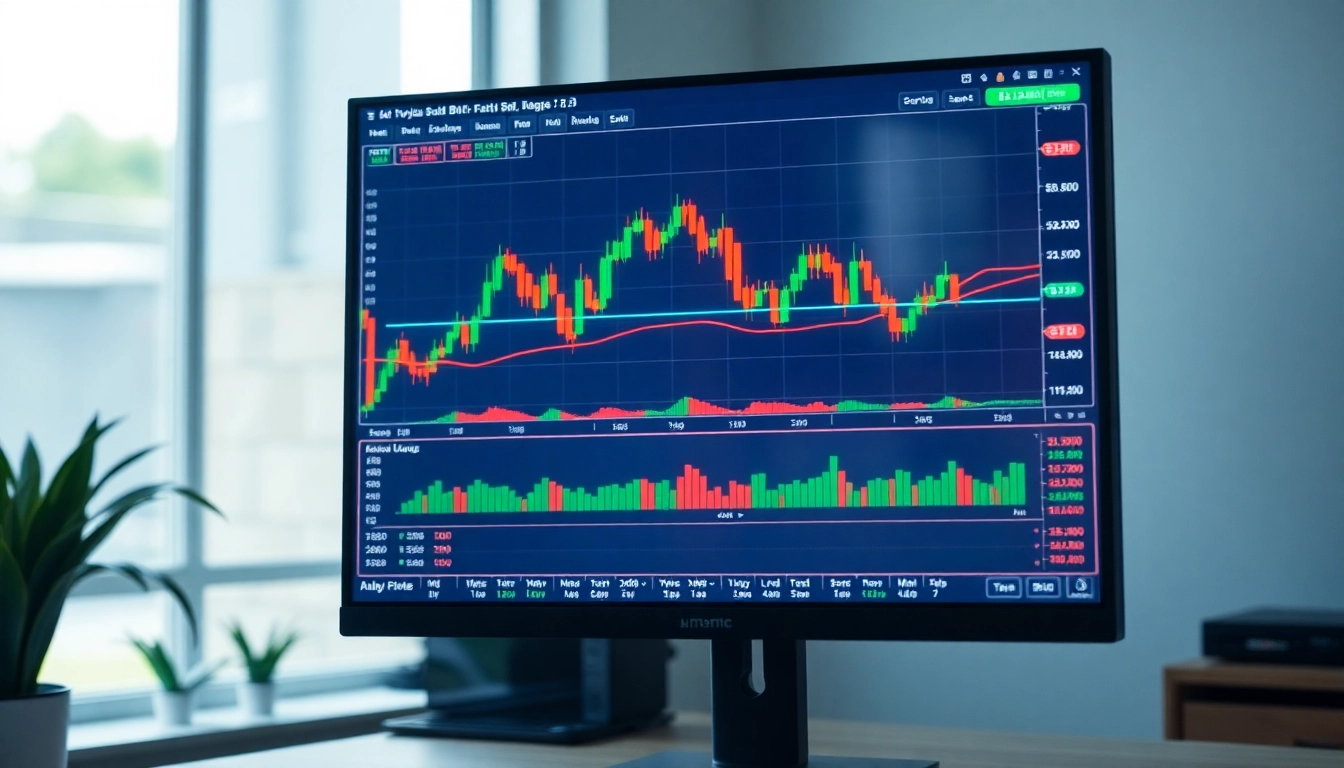
Mastering Market Analysis with Trading View: A Comprehensive Guide for Traders
In the fast-paced world of trading and investing, having access to real-time data, powerful charting tools, and a vibrant community can make the difference between a successful trade and missed opportunities. One of the most prominent platforms that cater to these needs is trading view. Recognized globally, Trading View offers a robust environment for both novice and professional traders to analyze markets across stocks, cryptocurrencies, forex, commodities, and more. This comprehensive guide explores how to optimize your use of Trading View, from setup to advanced analysis techniques, ensuring you stay ahead in the competitive world of trading.
Introduction to Trading View and Its Market Significance
What is Trading View? Overview and Core Features
Trading View is a leading financial analysis platform renowned for its advanced charting capabilities, social interaction, and extensive market coverage. It combines real-time data feeds, customizable charts, and a community-driven environment where traders share ideas, strategies, and insights. Its core features include interactive technical charts, a vast library of technical indicators and overlays, customizable watchlists, and social feeds that foster collaborative learning. As a versatile tool, Trading View supports desktop and mobile applications, enabling traders to stay connected with the markets anytime, anywhere.
Why Traders Rely on Trading View for Market Insights
Traders worldwide rely on Trading View for its comprehensive suite of analysis tools, real-time alerts, and community insights. Unlike traditional brokers or standalone charting tools, Trading View’s social features allow users to see diverse trading ideas and strategies, fostering a collaborative environment centered on shared market intelligence. Its flexible customizations, combined with access to multiple market data sources, enable traders to develop nuanced analyses, spot trends early, and adapt their tactics swiftly. Additionally, the platform’s user-friendly interface and integration with brokerage accounts streamline the transition from analysis to execution.
Identifying Your Trading Goals with Trading View
Before delving into technical analysis, it’s crucial to define clear trading objectives—whether you aim for short-term gains, long-term investment growth, or diversification into new assets. Trading View’s customizable tools allow you to tailor your workspace accordingly. For instance, if day trading stocks is your focus, you can set up real-time live charts with alerts on key price movements. Conversely, if swing trading cryptocurrencies, you might prioritize macro trend analysis and community forecasts. Clarifying your goals ensures that your use of Trading View aligns with your overall strategy, making your analysis more targeted and effective.
Setting Up Your Trading View for Optimal Performance
Creating Custom Watchlists and Alerts
One of the platform’s standout features is its ability to create personalized watchlists. Organize your favorite assets—be it stocks, crypto pairs, or forex currencies—into dedicated lists. This helps streamline your analysis routine and ensures you’re always focused on relevant markets. Moreover, setting alerts on specific price levels, technical indicator crossovers, or trend changes allows you to react promptly without constantly monitoring charts. For example, an alert on Bitcoin surpassing a selected resistance level can trigger an immediate review or trade execution, enhancing your responsiveness and reducing missed opportunities.
Utilizing Chart Tools for Precise Technical Analysis
Trading View offers an extensive array of charting tools, from trend lines and Fibonacci retracements to geometric shapes and text annotations. The platform supports multiple chart types—including candlestick, line, and bar charts—catering to various analytical preferences. By mastering these tools, traders can identify support and resistance levels, spot chart patterns like head and shoulders, and visualize key technical signals with clarity. Combining multiple overlays, such as moving averages with RSI indicators, allows for a multi-dimensional view of market conditions, enhancing decision-making accuracy.
Implementing Trading Strategies with Trading View Features
Strategies such as breakout trading, trend following, or mean reversion can be effectively implemented through Trading View. Use the platform’s drawing tools to identify entry and exit points, set up automated alerts, and backtest strategies against historical data. For instance, you might develop a breakout strategy on the S&P 500 by marking breakout levels with horizontal lines and monitoring volume spikes. The platform’s scripting language, Pine Script, enables advanced traders to develop custom indicators and automated trading bots, pushing analysis from theoretical to practical application seamlessly.
Advanced Techniques for Effective Market Analysis
Using Indicators and Oscillators to Predict Trends
Effective traders leverage technical indicators to anticipate market movements. Popular tools like Moving Averages, Bollinger Bands, MACD, and RSI help identify overbought or oversold conditions, trend strength, and potential reversals. Combining multiple indicators provides confirmation signals, reducing false positives. For example, a bullish crossover of short-term and long-term moving averages accompanied by a low RSI reading might suggest a strong buy signal. Continuously refining your indicator settings based on asset class and timeframe improves accuracy and aligns analysis with prevailing market dynamics.
Incorporating Social Feed and Community Ideas
Trading View’s social aspect is invaluable for gaining diverse perspectives. The community’s shared ideas, charts, and analyses can serve as initial filters or supplementary insights. Monitoring trending analysis in community ideas, especially during volatile periods, can reveal emerging patterns or consensus sentiments. For instance, during a cryptocurrency rally, observing the collective sentiment and expert opinions can provide context that complements your technical analysis, helping to make more informed trading decisions.
Backtesting Strategies and Reviewing Historical Data
Backtesting remains essential for validating strategies before real-money deployment. Trading View’s built-in backtester allows traders to run simulations on historical data, assess profitability, and optimize parameters. For example, a swing trader testing a moving average crossover system can analyze its performance over multiple market cycles, adjusting settings to maximize gains and minimize drawdowns. Consistent backtesting and review help identify overfitting risks and improve robustness in live trading environments.
Maximizing Trading View for Different Asset Classes
Analyzing Stocks, Cryptocurrencies, and Forex Markets
Different asset classes require tailored analysis approaches. Stocks often respond to fundamental news, but technicals can reveal entry points and trend directions. Cryptocurrencies, characterized by high volatility, benefit from real-time alerts and sentiment analysis. Forex markets, influenced by macroeconomic indicators, often require combining technical and fundamental analysis for currency pairs. Trading View consolidates all these markets into a single platform, allowing seamless comparison, multi-timeframe analysis, and cross-asset correlation studies to refine your strategies.
Leveraging Mobile and Desktop Platforms Seamlessly
Whether on your desktop or mobile device, Trading View delivers a consistent, feature-rich experience. Its mobile app ensures you can monitor markets, receive alerts, and even execute trades on the go. Synchronization across devices guarantees your setups and watchlists are always up to date. For traders with dynamic schedules, this mobility ensures they never miss crucial market movements or opportunities, maintaining an edge regardless of location.
Integrating Trading View with Other Trading Tools
For advanced traders, integration is key. Trading View supports linking with popular brokerage accounts through third-party APIs, automating trades based on analysis signals. Additionally, traders often combine Trading View with portfolio management software, economic calendars, and news aggregators. Proper integration streamlines workflows, reduces manual errors, and accelerates the path from analysis to execution, optimizing overall trading efficiency.
Measuring Success and Improving Your Trading Tactics
Monitoring Performance with Built-in Analytics
Trading View offers various analytics tools to evaluate trading performance. Visual dashboards can track win/loss ratios, profit factors, and drawdowns over time. Regular review of these metrics helps traders identify strengths and weaknesses, guiding adjustments to their strategies. For example, if backtested results reveal a pattern of false signals during sideways markets, traders can adapt by utilizing different indicators or timelines.
Staying Updated with Market News and Community Insights
Market news-driven events can drastically influence asset prices. Leveraging Trading View’s news feeds and community insights helps traders stay informed about macroeconomic releases, geopolitical developments, and industry-specific news. Incorporating these real-time updates into analysis enables more flexible and timely responses. Combining fundamental and technical insights provides a holistic view, reducing blind spots and enhancing decision-making quality.
Refining Strategies to Adapt to Market Changes
Markets are inherently dynamic; strategies that work in one environment may falter in another. Continuous learning, through backtesting and community interaction, allows traders to refine tactics. Regularly reviewing performance metrics, adjusting indicator parameters, and embracing new technical tools help sustain profitability and resilience against market volatility.




